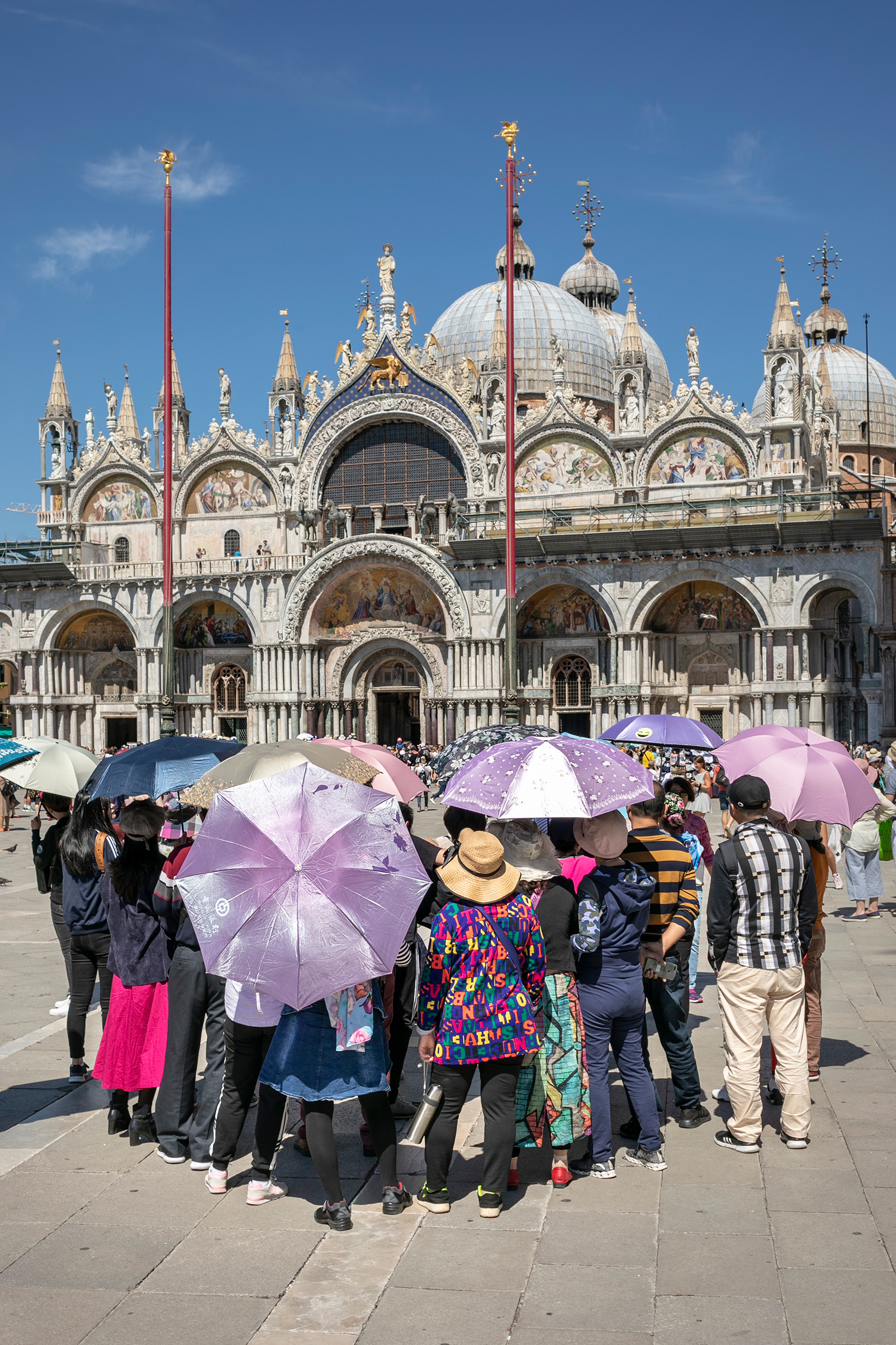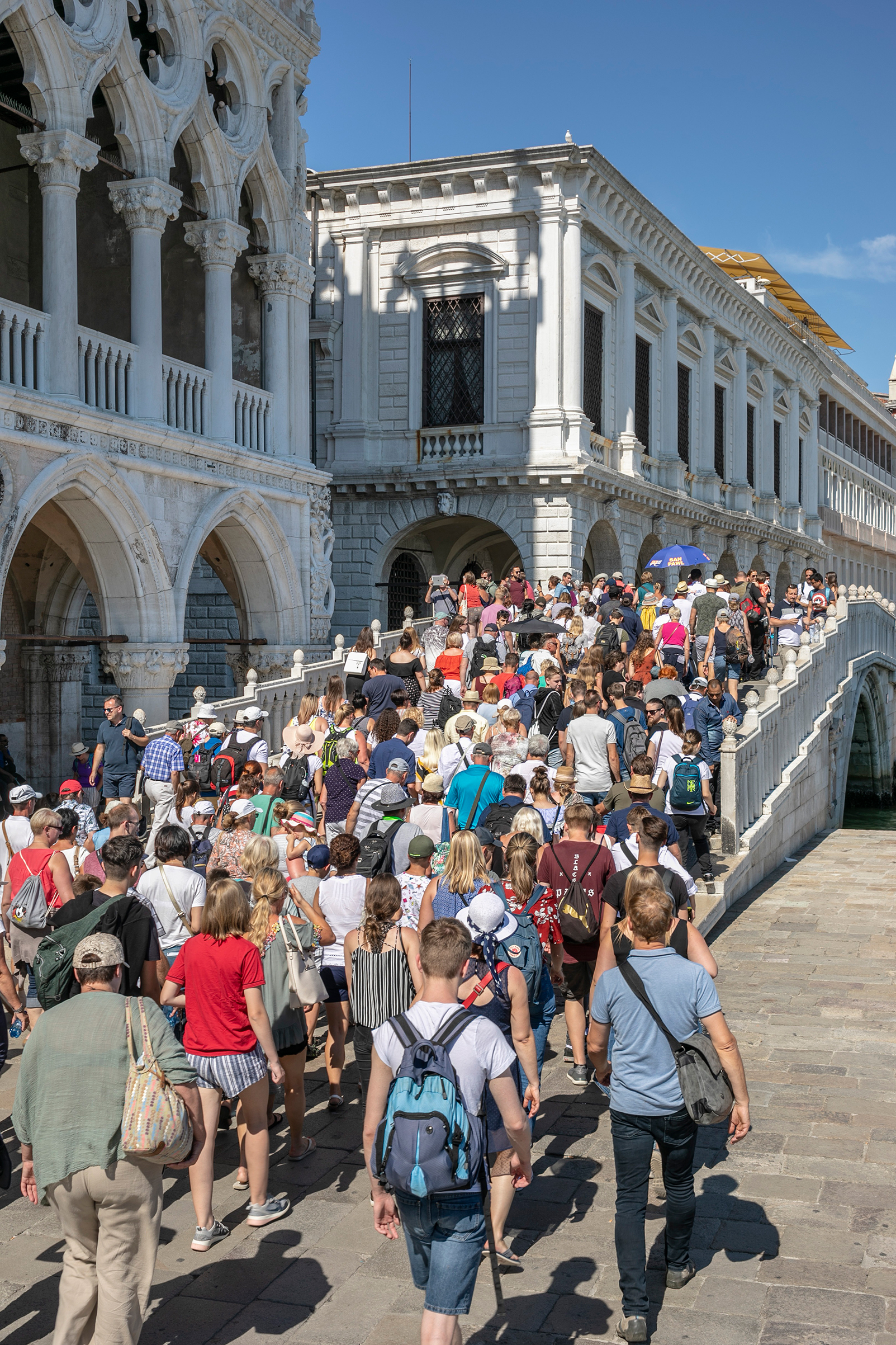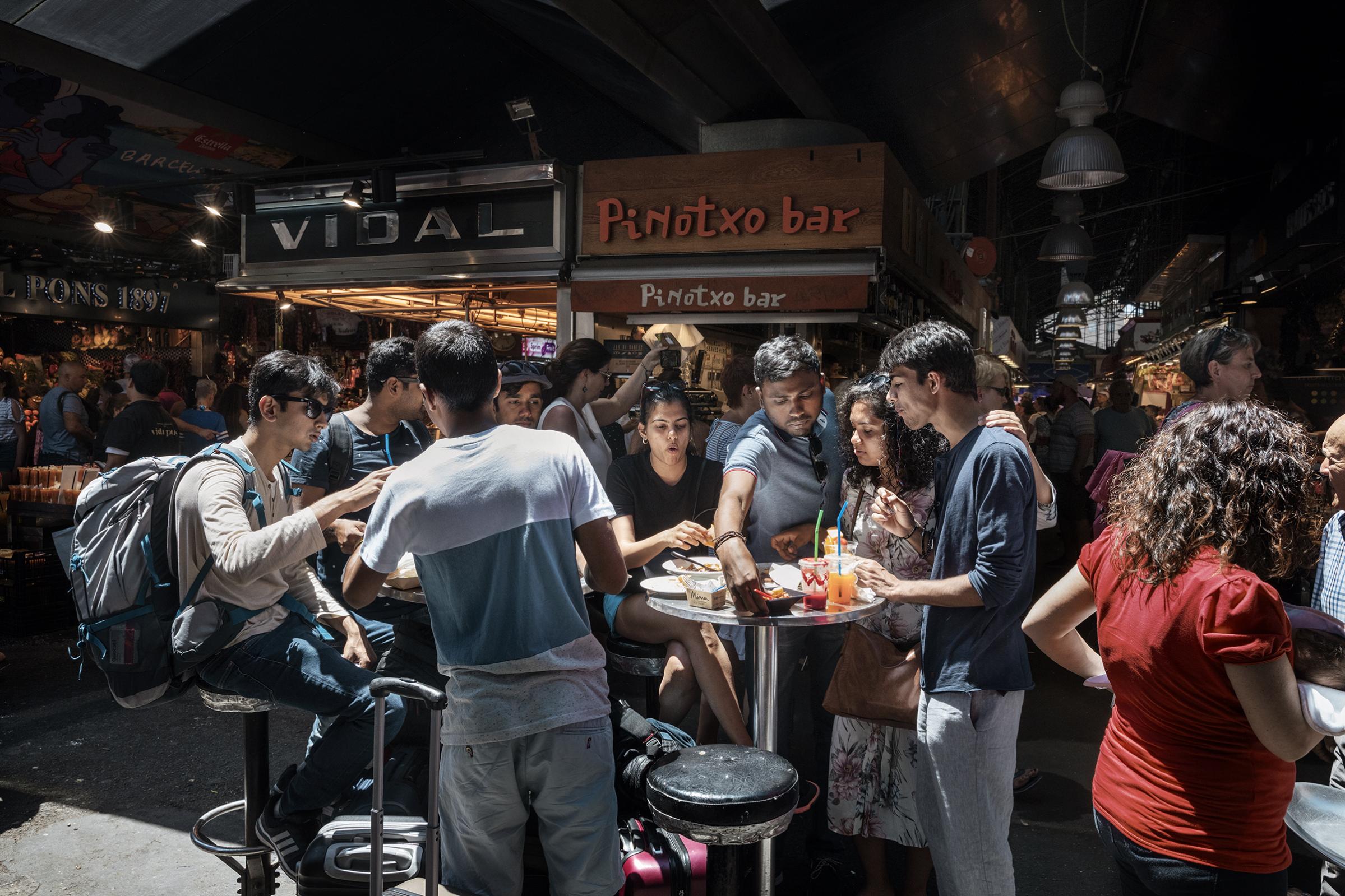
In Giovanni Bonazzon’s paintings, Venice is a vision of serenity. Bridges arch gracefully over rippling canals, sunlight bounces off flower-filled balconies, and not a single human mars the tranquility.
Bonazzon’s daily vista is not as tranquil, however. An artist who paints and sells watercolors from an easel set up near San Marco Square, he has a ringside seat to the selfie-posing, ice-cream-licking hordes who roil their way daily toward the Doge’s Palace, and he readily agrees that tourism is killing his hometown.
Yet when he heard that Venice Mayor Luigi Brugnaro had, in the run-up to a busy weekend at the beginning of May, installed checkpoints intended to block arriving visitors from especially crowded thoroughfares (while allowing locals through), Bonazzon was dismayed. “Yes, they should control the tourists,” he says. “But they shouldn’t close Venice. We’re a city, not a theme park.”
That’s a refrain echoing in a growing number of European cities. The neoclassical gems that once made up the grand tour have been stops on package tours since the 19th century. But it’s only over the past decade or so that the number of travelers to these and other must-see destinations risks subsuming the places. Around 87 million tourists visited France in 2017, breaking records; 58.3 million went to Italy; and even the tiny Netherlands received 17.9 million visitors.
It’s happening nearly everywhere. Asia experienced a 9% increase in international visitors in 2016, and in Latin America the contribution of tourism to GDP is expected to rise by 3.4% this year. Even a devastating hurricane season couldn’t halt arrivals in the Caribbean, where tourism grew 1.7% in 2017. (The U.S., on the other hand, has seen foreign tourism drop, partly because of a strong dollar.)
But Europe is bearing the brunt. Of the 1.3 billion international arrivals counted by the U.N. worldwide last year, 51% were in Europe–an 8% increase over the year before. Americans, in particular, seem drawn to the perceived glamour and sophistication of the Old Continent (as well as the increased spending power of a strong currency). More than 15.7 million U.S. tourists crossed the Atlantic in 2017, a 16% jump in the space of a year.
With tourism in 2018 expected to surpass previous records, frustration in Europe is growing. This past spring witnessed antitourism demonstrations in many cities throughout Europe. On July 14, demonstrators in Mallorca, Spain, conducting a “summer of action” greeted passengers at the airport with signs reading tourism kills Mallorca.

Now, local governments are trying to curb or at least channel the surges that clog streets, diminish housing supplies, pollute waters, turn markets and monuments into no-go zones, and generally make life miserable for residents. Yet almost all of them are learning that it can be far more difficult to stem the tourist hordes than it was to attract them in the first place.
The reasons for this modern explosion in tourism are nearly as numerous as the guys selling selfie sticks in Piazza Navona. Low-cost airlines like easyJet, Ryanair and Vueling expanded dramatically in the 2000s, with competitive ticket prices driving up passenger numbers. From 2008 to 2016, the cruise-ship industry in Europe exploded, growing by 49%. Airbnb, which launched in 2008, made accommodations less expensive. Rising prosperity in countries like China and India has turned their burgeoning middle classes into avid travelers. Even climate change plays a role, as warmer temperatures extend summer seasons and open up previously inaccessible areas.
But the cities and local governments here also share responsibility for the boom, having attempted to stimulate tourism to raise money. In the decade since the financial crisis began, tourism has come to be seen by European countries as an economic lifesaver. The industry generated $321 billion for the E.U. in 2016 and now employs 12 million people. Governments in cities like Barcelona spent heavily to attract tourist dollars. “For decades, the government here was using tons of public money to attract cruise lines, new hotels, new airlines,” says Daniel Pardo, a member of the city’s Neighborhood Assembly for Sustainable Tourism. “But they didn’t think about the repercussions.”
Barcelona is one of the cities that got more than it bargained for. Every day in high season now, four or five cruise ships dock in the Catalan capital, spilling thousands of passengers at the base of the famous Rambla Boulevard. “You can’t walk there,” Pardo says. “You can’t shop at the Boquería market. You can’t get on a bus, because it’s packed with tourists.”
Over the past few years, Barcelona has begun taking action to improve tourist behavior, like fining visitors who walk around the city center in their bathing suits. The current mayor, Ada Colau, has dramatically intensified that action. In January 2017, her government prohibited the construction of new hotels in the city center and prevents their replacement when old ones close. Cruise ships that stop for the day may struggle to get docking licenses, as the city prioritizes those that begin or end their journey in Barcelona. Tour groups can now visit the Boquería market only at certain times, and the city is considering measures to ensure locals can still buy raw ingredients there–and not just smoothies and paper cones of ham.
“There is a risk that some areas of the city, like Sagrada Familia or the Boquería, will become amusement parks,” says Agustí Colom, the city councilman for tourism. “But we’re still in time to save them. We understand that Barcelona cannot become an economic monoculture.”

Other places are also turning to the law to reduce the number of globetrotters. Ever since its medieval center stood in for King’s Landing on Game of Thrones, the walled Croatian city of Dubrovnik has been overwhelmed by fans of the HBO series. In 2017, Dubrovnik limited the number of daily visitors to 8,000; its new mayor now seeks to halve that amount. Amsterdam, whose infamous drug culture and picturesque canals drew at least 6 million foreign visitors to the city in 2016, has adopted a carrot-and-stick approach. The Dutch capital has introduced fines for rowdy behavior and banned the mobile bars known as “beer bikes,” while simultaneously attempting to lure visitors to less congested sites like Zandvoort, a coastal town 17 miles from the city center that has been rebranded Amsterdam Beach, through apps and messaging systems.
The city has also raised its tourist tax to 6%, joining several other cities and some countries that aim to control visitor numbers with higher levies. At the start of 2018, Greece imposed its first tourist tax, which ranges from roughly 50 cents a night to four euros. In Iceland, which receives nearly seven times as many visitors as it has residents, lawmakers will consider a tax this fall on tourists coming from outside of Europe.
Yet even in liberal Europe, not every government is willing to raise taxes. Authorities in the Lofoten Islands in northern Norway beseeched the government to raise levies after more than a million tourists visited in 2017, thanks in part to the movie Frozen. The 25,000 inhabitants found their single main road and its sparse facilities completely overwhelmed.
When Norway said no to higher taxes, the locals were forced to take matters into their own hands. “We’ve organized community volunteers to build trails and haul trash,” says Flakstad Mayor Hans Fredrik Sordal. “In summer, we’re opening the school toilets to the public. And we’re asking tourists for volunteer contributions.”
For locals in these places, anger at the ever-expanding rates of tourism can be placated by the money there is to be made out of catering to them. The advent of Airbnb has created a revenue stream for city-center residents with spare bedrooms and second properties. The company sees itself as an answer to tourism overcrowding rather than a net contributor. “We are convinced our community can be a solution to mass tourism,” wrote company founder Nathan Blecharczyk in a May report, “and that it enables sustainable growth that benefits everyone.”
Yet some people benefit more than others. Canny investors buy up residential properties in desirable locations and convert them into tourist apartments, provoking housing shortages and pushing up prices. Again, some cities have taken action. Copenhagen, for example, has limited the number of days per year that owners can rent out their residences. Barcelona has targeted Airbnb itself, forcing it to share data about owners and remove listings for unlicensed apartments. It has also launched a website where visitors can check if a potential apartment is legally registered. But speculators are hard to deter, especially as Airbnb doesn’t require owners to reside in housing that is rented through the site.
Balancing the needs of locals with the demands of tourists is a challenge across Europe but perhaps nowhere more so than in Venice, where more than 20 million tourists crowd the piazzas and canals every year. When the city’s mayor attempted to install checkpoints to potentially shut main thoroughfares to tourists, the initiative was greeted by protests from locals, who saw the surprise measure as an attempt to close the city. “We tried to do something for the city, for the residents,” laments Paola Mar, Venice’s deputy mayor for tourism. “This measure was for them, for their safety. But in Italy, you’re only good if you do nothing.”
Venice has not done nothing. The local government has restricted the construction of new hotels and takeout restaurants, and created a fast lane for residents on public transport. It has a plan in place to ease congestion by diverting foot and boat traffic on exceptionally crowded days this summer, and now employs 22 stewards in vests that read #EnjoyRespectVenezia to prevent tourists sitting on monuments, jumping in the canal, or otherwise misbehaving.

But imposing too many restrictions risks alienating the residents who depend on access to tourist dollars; across the E.U., 1 in 10 nonfinancial enterprises now serves the industry. In Venice, a proposal to ticket the entrance to San Marco Square has run into resistance from shopkeepers. And the subject of restricting cruise-ship access is a touchy one. “You have to know, 5,000 people work with the cruise ships,” says Mar, who notes that the city council has asked the government to move large ships from the San Marco basin. “If we want people to stay in Venice, they have to have jobs.”
And therein lies a hint of what is at stake. Venice has been losing residents for decades, dropping from nearly 175,000 in 1951 to around 55,000 now. The city seems close to uninhabitable in certain areas–its streets too crowded to stroll down, its hardware shops and dentist offices replaced by souvenir stalls. The same cycle threatens Barcelona and Florence; tourism drives locals out of the center, which then leaves even more spaces to be colonized by restaurants and shops that cater to tourists. Annelies van der Vegt understands the sentiment. A musician, she lives in the center of Amsterdam but is tired of finding entire tour groups on her doorstep, gaping at her 17th century house. “I’m thinking of moving to Norway,” she says.
When the residents leave and the visitors take over, what is left behind can lose some of its charm. One day in May, Susana Alzate and Daniel Tobón from Colombia waited on Venice’s Rialto Bridge as first a gaggle of Israeli Orthodox Jews, then a tide of Indian Sufis jostled by. Finally, the couple found a slot on the railing, struck a pose and shot their Instagram story. “It’s beautiful,” said Alzate as she gazed out on the Grand Canal. “But I would never come back. Too many tourists.”
More Must-Reads From TIME
- The 100 Most Influential People of 2024
- Coco Gauff Is Playing for Herself Now
- Scenes From Pro-Palestinian Encampments Across U.S. Universities
- 6 Compliments That Land Every Time
- If You're Dating Right Now , You're Brave: Column
- The AI That Could Heal a Divided Internet
- Fallout Is a Brilliant Model for the Future of Video Game Adaptations
- Want Weekly Recs on What to Watch, Read, and More? Sign Up for Worth Your Time
Contact us at letters@time.com